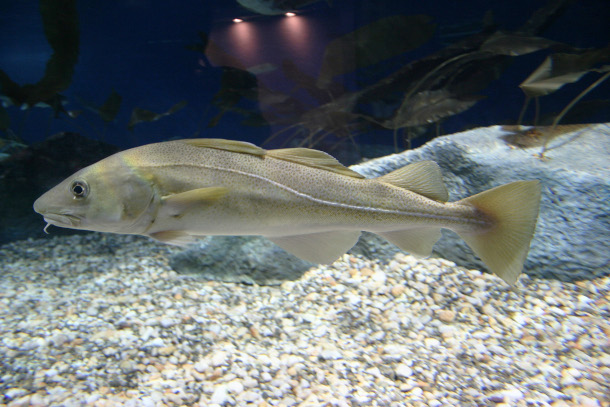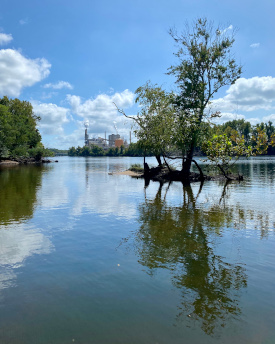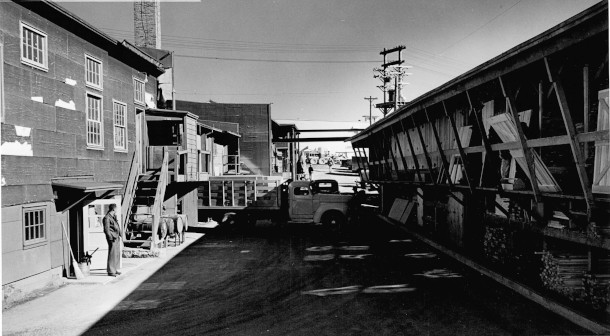Beyond the Headlines
Air Date: Week of July 28, 2023

In Iceland, waste from the seafood industry is being repurposed in leather, blood-clotting agents, and collagen supplements. Skin from the Atlantic cod (shown above) has even been used in human skin grafts. (Photo: The Maritime Aquarium at Norwalk, Flickr, CC BY-ND 2.0)
In this week’s trip beyond the headlines, Living on Earth contributor Peter Dykstra joins host Steve Curwood to discuss the ways in which Iceland is repurposing the waste from fish catch, from skin grafts to pharmaceuticals. Then, the two take a look at the string of homes being built in North Carolina’s floodplains seemingly incentivized by the state’s flood buyout program. Finally, for history the pair discuss the life of Kenneth Bainbridge, who directed the first successful test of the atom bomb.
Transcript
CURWOOD: On the line now from Atlanta, Georgia, is Peter Dykstra, contributor to Living on Earth, with fascinating stories beyond the headlines. Hey, Peter, what do you have for us today?
DYKSTRA: Hi, Steve. We'll go to Iceland, where their longstanding traditional economy of fishing and tourism may be getting a boost, because efforts are underway to see that all that fish waste goes to a second life. Icelanders have found a way to use skin from codfish as a replacement for human skin in severe burn victims.
CURWOOD: Wait, Peter, you're saying that they're using fish for skin grafts on people, it sounds like.
DYKSTRA: Yeah, and they say it looks a little like fish skin, but it can be a godsend to people who have those severe burns. They cite an electrocution victim, much of whose torso was compromised, who's now walking around in a cod skin. Moreover, for the business side of this, the company that's invented this new way to use cod waste just sold for over a billion dollars.
CURWOOD: That's pretty amazing. And of course, you know, you think of fish waste just, what? Being made into meal for pets or something like that. But this sounds like a lot more ambition.
DYKSTRA: Or thrown out just as something kind of smelly. Fish like Atlantic salmon are being reprocessed into leather for high fashion industry. And chitosan, that shell that some crustaceans like shrimp are encased in, are used and transformed into a blood-clotting agent.
CURWOOD: Right, rather efficient, I would say.
DYKSTRA: E-FISH-ent. Nice.
CURWOOD: Hey, what else do you have for us?
DYKSTRA: Here's one that's not quite so efficient. In the state of North Carolina, the University of North Carolina studied the flood buyout program, where the state offers to buy properties that are in harm's way from floods. They've bought about 5000 such homes, but they've apparently let about 10 times as many new homes be built in floodplains. That's sort of taking a solution and replacing it with a bigger problem.

A study finds that, for every flood-prone house bought out by the North Carolina government from 1996 to 2017, 10 more were built in a floodplain. (Photo: Matt Walter, Flickr, CC BY-SA 2.0)
CURWOOD: Well, because people know that, hey, if they build a house, the state will come and buy it out if they get flooded out.
DYKSTRA: That's right. That's not just a problem in North Carolina. It's a problem everywhere, particularly in coastal areas, that promises only to get worse as sea level rise and more frequent storms, two of the calling cards of global warming, come to claim more coastal properties.
CURWOOD: Peter, that story reminds me that many in the media have not really paid a whole lot of attention to the risks and consequences of climate change. How much do you think that's changing these days, with the extreme weather?
DYKSTRA: It's changing. It's changing as much as someone like you or me would have liked to have seen it change 20 and 30 years ago. There's a big 'I told you so' to be said by environmental journalists who were, no pun intended, blown off for years, to see that the mainstream media is finally noticing these deluges, these atmospheric rivers causing unprecedented floods, unprecedented wildfires, unprecedented storms, everywhere, not just in the United States, but throughout the world. We knew it was going to happen everywhere. And even if people are listening way too late, it's better than not listening at all.
CURWOOD: Well, and it's not too late to do something, because it's just going to keep getting worse if we don't make a change. Hey, what do you have from the annals of history for us today?
DYKSTRA: We'll go back to July 27th, 1904. One of the key people to ushering in the Atomic Age, Kenneth Bainbridge, was born. He actually led the project under Oppenheimer and General Leslie Groves to build and detonate the first atomic bomb, which also happened in the month of July, back in 1945.

July 27, 2023, would have been the 119th birthday of Kenneth Bainbridge, a physicist in charge of the first detonation of an atomic bomb. That explosion, codenamed “Trinity,” took place south of Los Alamos, New Mexico. Above, a maintenance area at Los Alamos National Laboratory. (Photo: United States Department of Energy, Wikimedia Commons, public domain)
CURWOOD: Yes, and I met Professor Bainbridge in a freshman seminar when I was a student at Harvard. They offered a nuclear physics seminar, and, actually, he did show us about cyclotrons, and I did learn some nuclear physics. In fact, I use it in this work. But he spent most of the time saying he had a lot of regrets about that so-called "Manhattan Project," developing and exploding the nuclear bombs. And, famously, he said to Oppenheimer, when they had the first very successful test, that now we are all sons of bitches.
DYKSTRA: That's right. And Oppenheimer had those same regrets.
CURWOOD: And it's a reminder, and Professor Bainbridge made this clear, it's a reminder that any technology that we develop as scientists, we need to think about what the social implications are. It's not just abstract science, it will have an impact on people.
DYKSTRA: That's right.
CURWOOD: Well, thanks, Peter. Peter Dykstra is a regular contributor to Living on Earth. And we'll talk to you again real soon.
DYKSTRA: All right, Steve. Thanks a lot, and we'll talk to you soon.
CURWOOD: And there's more on these stories at the Living on Earth webpage. That's loe.org.
Links
Read about efforts in Iceland to repurpose fish waste
Living on Earth wants to hear from you!
Living on Earth
62 Calef Highway, Suite 212
Lee, NH 03861
Telephone: 617-287-4121
E-mail: comments@loe.org
Newsletter [Click here]
Donate to Living on Earth!
Living on Earth is an independent media program and relies entirely on contributions from listeners and institutions supporting public service. Please donate now to preserve an independent environmental voice.
NewsletterLiving on Earth offers a weekly delivery of the show's rundown to your mailbox. Sign up for our newsletter today!
 Sailors For The Sea: Be the change you want to sea.
Sailors For The Sea: Be the change you want to sea.
 The Grantham Foundation for the Protection of the Environment: Committed to protecting and improving the health of the global environment.
The Grantham Foundation for the Protection of the Environment: Committed to protecting and improving the health of the global environment.
 Contribute to Living on Earth and receive, as our gift to you, an archival print of one of Mark Seth Lender's extraordinary wildlife photographs. Follow the link to see Mark's current collection of photographs.
Contribute to Living on Earth and receive, as our gift to you, an archival print of one of Mark Seth Lender's extraordinary wildlife photographs. Follow the link to see Mark's current collection of photographs.
 Buy a signed copy of Mark Seth Lender's book Smeagull the Seagull & support Living on Earth
Buy a signed copy of Mark Seth Lender's book Smeagull the Seagull & support Living on Earth

